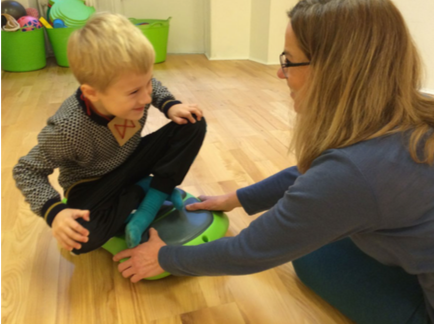By Physiotherapist Hannah Harboe
 The theme of this month’s Gonge Insights is cocontraction and fall reactions and how our senses influence both these functions. We bring a case, in which the FloorSurfer® is used to train both cocontraction and fall reaction.
The theme of this month’s Gonge Insights is cocontraction and fall reactions and how our senses influence both these functions. We bring a case, in which the FloorSurfer® is used to train both cocontraction and fall reaction.
Cocontraction
A child’s ability to cocontract depends on his/her awareness of proprioceptive stimuli (i.e. senses muscles and joints). The better and more accurately a child can register stimulation of the proprioceptive receptors, the easier and more refined his/her response – and the quality of his/her movements – will be.
The more vestibular (balance - see Gonge Insights no. 2) stimulation, including speed, acceleration and deceleration, we are exposed to, the better we stimulate our capacity to cocontract and our ability to register proprioceptive stimuli.
For most people, reacting too slowly triggers a fall reaction.
Fall reactions
When a child does not register proprioceptive input or overreacts to stimuli, he/she loses his/her balance. In other words, if cocontraction is not fast enough, a fall reaction is triggered, i.e. the individual cushions the fall using the hands.
Fall reactions are important as they protect us from falling and injury.
Using the arms in a fall reaction is important as the arms protect the face and head from injury.
If cocontraction is weak or if the vestibular system overreacts, the fall reaction is triggered too slowly or too violently. If fall reactions are too slow, the child will fall and injure himself/herself as the hands do not react fast enough to cushion the fall.
Fall reactions are a type of “emergency brake”. They are reflexes whereas the ability to maintain one’s balance and remain stable in a position requires finely-tuned sensory integration, which not only depends on registration of vestibular and proprioceptive stimuli, but is also heavily reliant on visual stimuli.
Case
John (aged 6) has undergone an operation, which damaged the nerve pathways in his abdominal muscles, resulting in reduced abdominal muscle strength. His ability to contract his abdominal muscles is impaired. He is afraid he will fall because he can feel that his muscles do not react as they used to.
To train John’s muscles and improve his fall reactions and muscle speed, I ask John to sit cross-legged on the Floor Surfer® with his hands on his knees (see photo).
I tell John that I will move the Floor Surfer® in a circle. When I give the signal: “Now!”, the Floor Surfer® will move in the opposite direction.
If John is unable to keep his balance, he will cushion the fall using his hands to avoid falling to the floor. If John reacts in time, he will be able to keep his hands on his knees and react by cocontracting the diagonal abdominal muscles in the opposite direction to the direction of travel.
To prevent injury, it is important that John has good fall reactions. However, it would be best if he could get his abdominal muscles to react quickly and therefore avert triggering a fall reaction.
The goal of this exercise is to get John to manage six changes of direction on the Floor Surfer® without removing his hands from his knees. Every time his hand touches the floor, we start again.
He has a clear goal, which motivates John and makes it easy for him to see that he is making progress.
The exercise is simple and John finds it fun because he makes rapid progress. We agree that he can do this exercise daily at home with his parents.
I know that this exercise requires integration of the vestibular, proprioceptive and visual sensory impressions. This means that I can adjust several parameters if John is unable to master the exercise or if it becomes too easy.
I can reduce the level of vestibular stimulation by moving the Floor Surfer® more slowly and increase the level of stimulation by accelerating or changing direction rapidly. Similarly, I can reduce proprioceptive stimulation by supporting John around his hips or holding his upper arms so that he does not have to support his whole body. To make the exercise more difficult, I can ask him to hold his hands on his head instead of on his knees. This increases the load on John’s weak, diagonal abdominal muscles.
To make the exercise easier visually, I can ask John to focus on a specific spot and tell him that we will change direction each time he hits this spot. To make it visually more difficult, he closes his eyes. He has no visual stimuli to help and receives information only from the vestibular and proprioceptive sensory systems.
When John turns up for training next time, we will adjust some of these parameters, depending on how things have gone with training at home. I guess that John will have fun training with the Floor Surfer® for some time – probably for longer than he needs to train to a better functional level than before his operation!
For more information and to purchase this product, please click here
© Gonge Creative Learning Aps 2018





